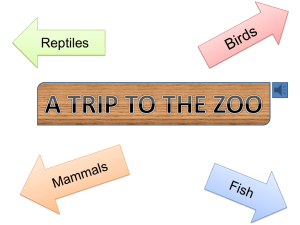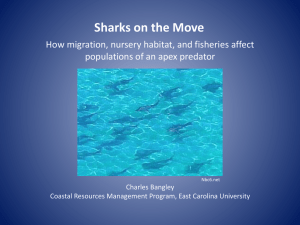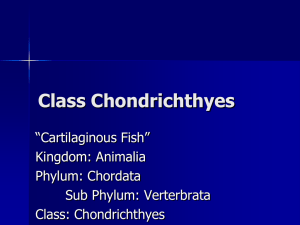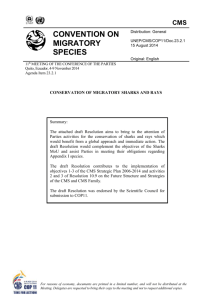Draft Resolution on Sharks and Rays
advertisement
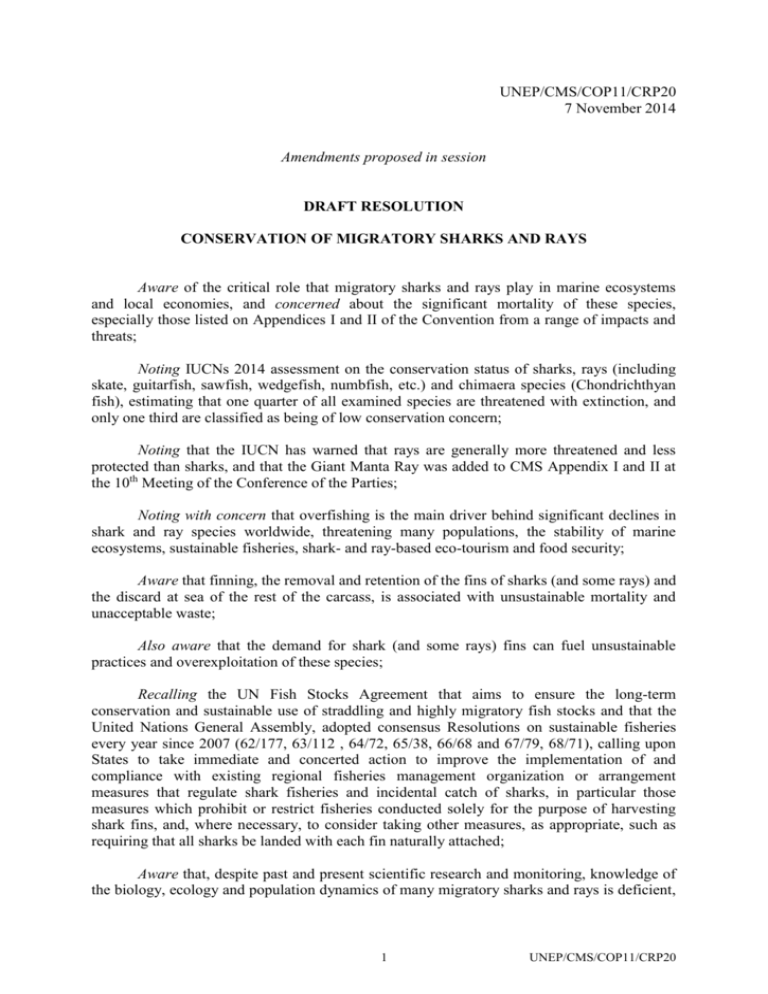
UNEP/CMS/COP11/CRP20 7 November 2014 Amendments proposed in session DRAFT RESOLUTION CONSERVATION OF MIGRATORY SHARKS AND RAYS Aware of the critical role that migratory sharks and rays play in marine ecosystems and local economies, and concerned about the significant mortality of these species, especially those listed on Appendices I and II of the Convention from a range of impacts and threats; Noting IUCNs 2014 assessment on the conservation status of sharks, rays (including skate, guitarfish, sawfish, wedgefish, numbfish, etc.) and chimaera species (Chondrichthyan fish), estimating that one quarter of all examined species are threatened with extinction, and only one third are classified as being of low conservation concern; Noting that the IUCN has warned that rays are generally more threatened and less protected than sharks, and that the Giant Manta Ray was added to CMS Appendix I and II at the 10th Meeting of the Conference of the Parties; Noting with concern that overfishing is the main driver behind significant declines in shark and ray species worldwide, threatening many populations, the stability of marine ecosystems, sustainable fisheries, shark- and ray-based eco-tourism and food security; Aware that finning, the removal and retention of the fins of sharks (and some rays) and the discard at sea of the rest of the carcass, is associated with unsustainable mortality and unacceptable waste; Also aware that the demand for shark (and some rays) fins can fuel unsustainable practices and overexploitation of these species; Recalling the UN Fish Stocks Agreement that aims to ensure the long-term conservation and sustainable use of straddling and highly migratory fish stocks and that the United Nations General Assembly, adopted consensus Resolutions on sustainable fisheries every year since 2007 (62/177, 63/112 , 64/72, 65/38, 66/68 and 67/79, 68/71), calling upon States to take immediate and concerted action to improve the implementation of and compliance with existing regional fisheries management organization or arrangement measures that regulate shark fisheries and incidental catch of sharks, in particular those measures which prohibit or restrict fisheries conducted solely for the purpose of harvesting shark fins, and, where necessary, to consider taking other measures, as appropriate, such as requiring that all sharks be landed with each fin naturally attached; Aware that, despite past and present scientific research and monitoring, knowledge of the biology, ecology and population dynamics of many migratory sharks and rays is deficient, 1 UNEP/CMS/COP11/CRP20 and that it is necessary to promote stronger co-operation among fishing nations on research, monitoring, enforcement and compliance in order to effectively implement conservation measures; Noting that several RFMOs have adopted science-based conservation and management measures, applicable to all fishing vessels operating within the RFMO Convention areas, aiming at eradicating shark finning and ensuring protection and sustainable management of specific sharks species harvested as target and/or bycatch species; Further noting that, with effect from 14 September 2014, eight species of shark and all manta rays are included in Appendix II of the Convention on the International Trade in Endangered Species (CITES), and that all species of sawfishes are listed in Appendix I; Emphasizing the importance of the International Plan of Action for the Conservation and Management of Sharks, which was adopted by the Food and Agriculture Organization (FAO) of the United Nations in 1999, in providing guidance on the development of such measures, and welcoming the fact that 18 out of 26 top fishing nations have adopted National Plans of Action for Sharks (NPOA-Sharks); Further emphasising the prominent role of RFMOs in establishing conservation and management measures for sharks, many of which are binding upon all fishing vessels operating within the RFMO convention areas, based on best available data and scientific advice provided by their Scientific Committees; Recalling Recommendation 8.16 on the Conservation of Migratory Sharks requesting all Parties to strengthen measures to protect migratory shark species against threats, including habitat destruction, IUU fishing, and fisheries bycatch; and Recalling the establishment of the CMS Memorandum of Understanding on the Conservation of Migratory Sharks (Sharks MoU) in 2010, which aims to achieve and maintain a favourable conservation status for migratory sharks based on the best available scientific information, taking into account the socio-economic and other values of these species, and the first Meeting of the Signatories in 2012 where the Conservation Plan for Migratory Sharks was adopted. The Conference of the Parties to the Convention on the Conservation of Migratory Species of Wild Animals 1. Urges Parties to ensure that all fishing and trade of sharks and rays are ecologically sustainable, and that a lack of scientific data does not preclude conservation or fisheries management action towards this objective; 2. Urges Parties to take steps to eliminate shark finning where they have not already done so, including implementing measures such as prohibiting the removal of sharks fins at sea and discarding the carcass at sea, requiring sharks to be landed with all fins naturally attached, or other measures in line with applicable UN General Assembly Resolutions; 3. Urges Parties, where they have not already done so, to develop and implement National Plans of Action for Sharks (NPOA-SHARKS) in accordance with FAO’s International Plan of Action for Sharks - IPOA-SHARKS; 2 UNEP/CMS/COP11/CRP20 4. Urges CMS Parties to comply with existing conservation and management measures in particular those of Regional Fisheries Management Organizations (RFMOs), where applicable, including compliance with data collection and submission requirements/ obligations to allow for reliable stock assessments by the Scientific Committees of these bodies; 5. Urges Parties to develop and implement guidelines and procedures for implementing the provisions of CITES regulating the trade of shark products deriving from species listed under the Appendices of the Convention; 6. Encourages Parties to identify the needs of training and capacity development in research, species specific data collection and monitoring, and to facilitate initiatives to enhance institutional capacities and competencies in shark and ray identification, management and conservation techniques; 7. Requests Parties to improve the biological and ecological knowledge of migratory elasmobranchs populations and identify ways to make fishing gears more selective to support effective conservation measures through research, monitoring and information exchange and promote population assessments and research including within the frame of RFMOs and their scientific bodies where applicable; 8. Encourages Parties to prioritize programmes to monitor and document directed shark and ray fisheries and those fisheries where sharks and rays are a significant bycatch, which may include vessel monitoring systems, inspections and on-board observer or monitoring programmes; 9. Encourages Parties, where appropriate, to promote the establishment of science-based conservation targets for migratory sharks and rays, and indicators to assess progress towards reaching these targets, including within the RFMOs where applicable; 10. Requests Parties to identify and conserve critical habitats and life stages, and migration routes, with a view to contributing to the development and implementation of effective conservation and sustainable management measures, based on the best available scientific knowledge and the precautionary approach; 11. Encourages Parties, RFMOs and other relevant bodies to minimize the impact of fishing in migration corridors and other habitats deemed critical to the recovery and sustainability of shark and ray populations, including those that straddle jurisdictional boundaries; 12. Invites Parties, Range States, and Cooperating Partners to sign the Sharks MOU and engage in conservation and research measures in order to prevent the unsustainable use of sharks and rays; 13. Instructs the Secretariat to continue to liaise with FAO, RFMOs, CITES, civil society and other relevant stakeholders in order to promote coordinated actions for the conservation and sustainable use of sharks and rays; and 14. Encourages Parties to bring to the attention of FAO, RFMOs and other relevant bodies the objectives of CMS and the CMS Sharks MOU with regard to the Conservation of Sharks 3 UNEP/CMS/COP11/CRP20 and Rays with the aim to ensure cooperation, complementarities and improve efficiency of global instruments and bodies sharing similar objectives in relation to elasmobranchs conservation and management. 4 UNEP/CMS/COP11/CRP20



